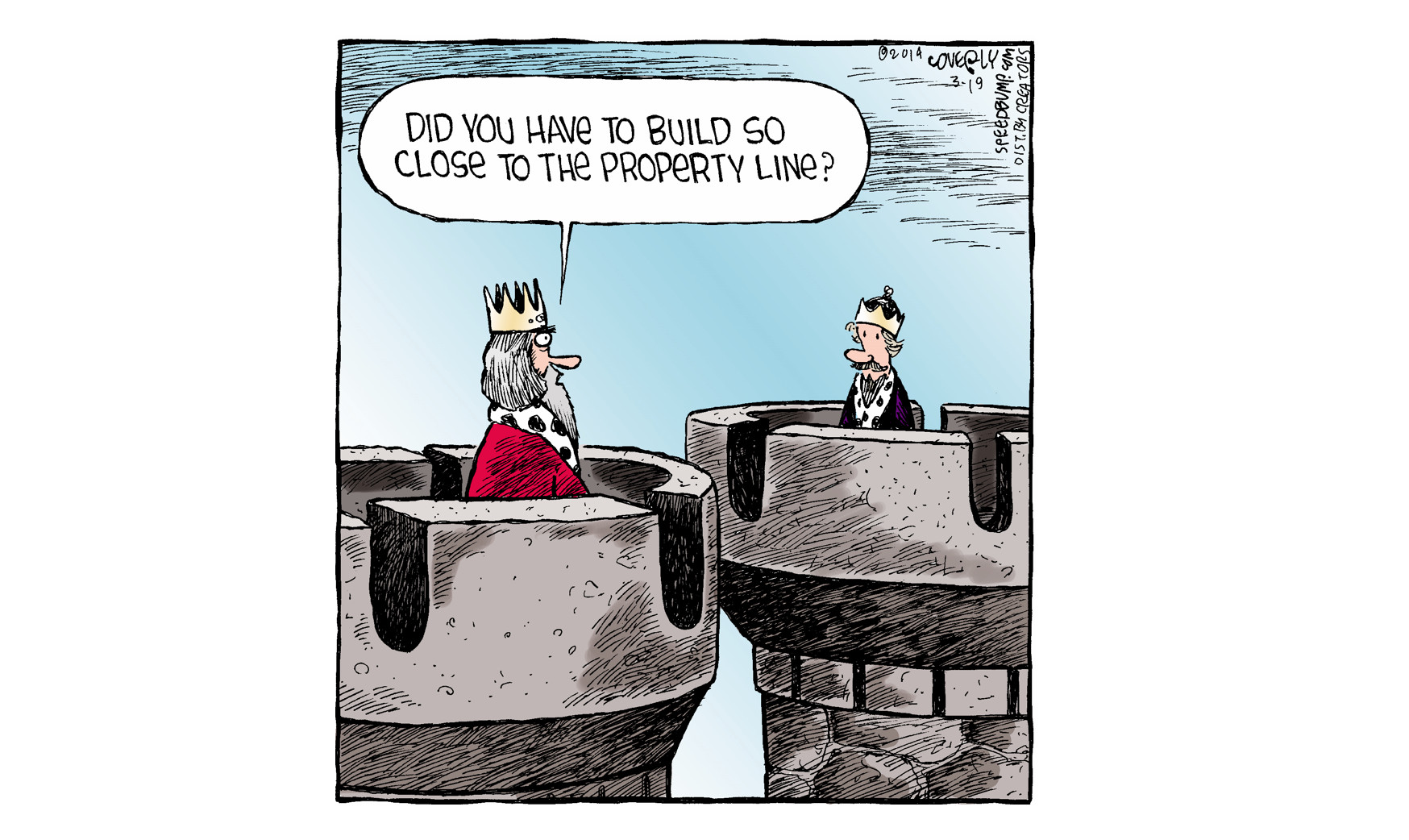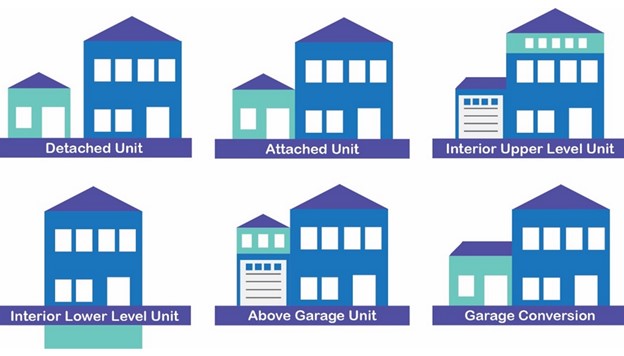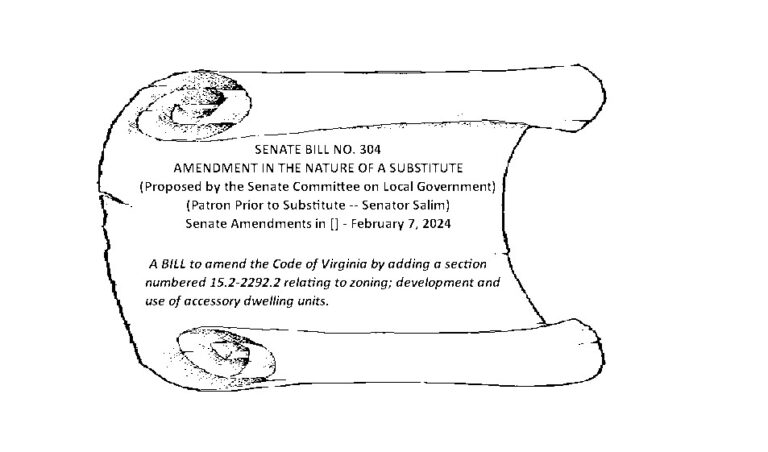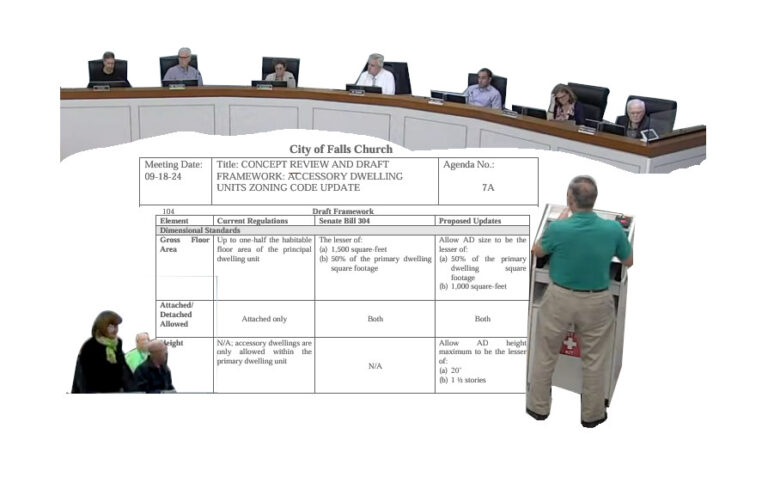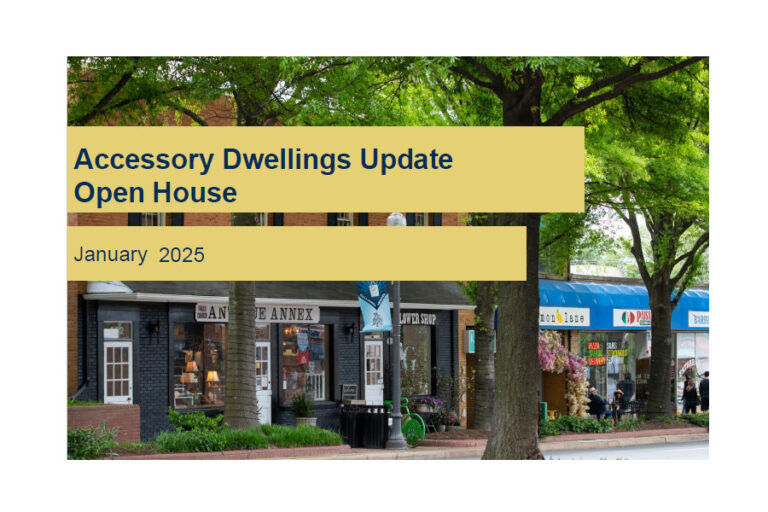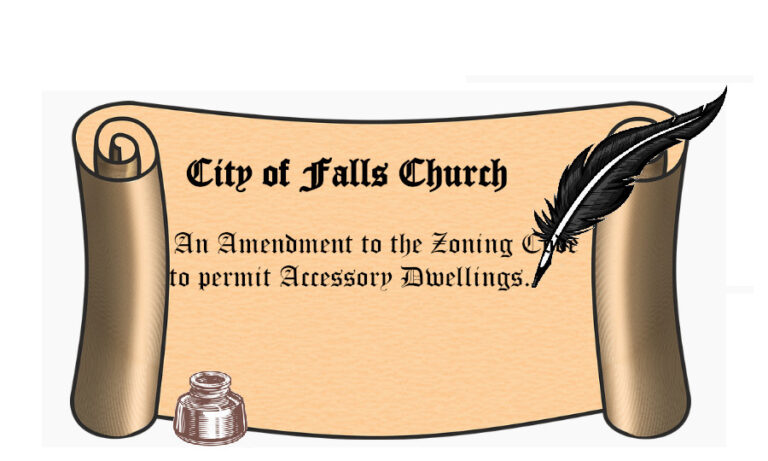Staff’s Accessory Dwelling Code Does Not Regulate Short-Term Rentals or Require Owner Occupancy
(Feature image courtesy of Dave Coverly.)
Summary
- City staff have laid out Code language, with some key changes in height and setbacks.
- Process, short-term rentals, and owner occupancy requirement came in for heavy hits in the City Council discussion.
- Staff promised more analysis: How many lots can support ADs? What is the City fiscal impact? Would smaller land disturbance cause stormwater problems? Can the cost of utility hook-ups be reduced? Should “structures” without ovens still be dwellings?
- Planning Commissioners were also upset about short-term rentals, the deletion of owner occupancy requirements, and permitted heights and setbacks. One Commissioner insists on using taxes on ADs for a housing fund.
Background
Following City Council and Planning Commission work sessions in September to discuss the City staff’s proposed “framework” for action on accessory dwellings (ADs), and two public town hall sessions, City staff sat down to write actual Code language to reflect the desired changes. [See Pulse posts City Council Reviews Draft “Framework” for Accessory Dwellings Zoning Ordinance, September 19, 2024, and Planning Commission, Citizens Urge Caution on Accessory Dwelling Framework during Community Discussions, October 9, 2024.]
The rationale for Accessory Dwelling code changes
The new City staff report and proposed Code provisions were submitted to the City Council on October 31 for the November 4, 2024, Council work session, and subsequent Planning Commission work session on November 6.
The staff report summarized the rationale for code changes permitting a range of accessory dwellings as follows:
“Regulations on accessory dwellings have been adjusted in some localities across the country as a tool for increasing housing availability and reducing housing costs while having limited impacts on community character or sense of place. Common uses for accessory dwellings include housing for extended family members or family members that need to live nearby and providing a source of supplemental income for homeowners.”
The report further notes that the current Zoning Ordinance only permits internal accessory dwellings and requires that the Board of Zoning Appeals (BZA) issue a Special Use Permit for the AD. Both of these restraints would change under the new approach. While there are no current ADs in the City, staff acknowledged that “there are several in-home improvements and accessory structures in the City that come close to meeting the definition of being a ‘Dwelling Unit’”. (A key distinction has been the absence of an oven, as determined by the previous Zoning Administrator.)
Highlights of the code changes
Staff made a few key changes in the proposed regulations from their September framework approach:
- New: Current Code language on internal ADs would be eliminated and a new Division 12 would be provided on ADs generally, covering internal, attached, and detached units. Accessory units would be limited to the lesser of 1,000 square feet of habitable space or 50% of the habitable area of the principal dwelling.
- New: For detached units, the maximum height would be the lesser of 25 feet or 2 stories. The setback requirement would be 5 feet from the side and rear lot lines for ADs up to 20 feet in height or 1-1/2 stories, and 10 feet for all others.
- New: While both the principal dwelling and the AD would have common ownership, the owner would not be required to live in either space, opening the door to owners or investors living at a distance from the City.
- The current requirement for one off-street parking space for an interior unit would be eliminated, requiring AD residents to either park on the street or rely on other means of transportation.
- There would be no regulation of long or short-term rentals, which could be addressed as part of a City-wide policy later.
- Current City regulations permitting a maximum building coverage of 25% of the lot, and impermeable coverage of 35%, would remain. There would be no change in the 20% minimum tree canopy requirement. However, more consideration is being given to whether the minimum 2,500 square foot disturbance of land for a grading plan could be reduced to help address any stormwater issues.
- ADs under the new approach could be built by-right, with just the normal building, fire, and safety requirements and no review by the BZA. However, conversion to an AD of non-conforming accessory structures (a garage or shed built before January 1, 2024) would require a Special Use Permit by the BZA, considering “the adjacent uses and structures, and the probable effect upon them of the proposed use”.
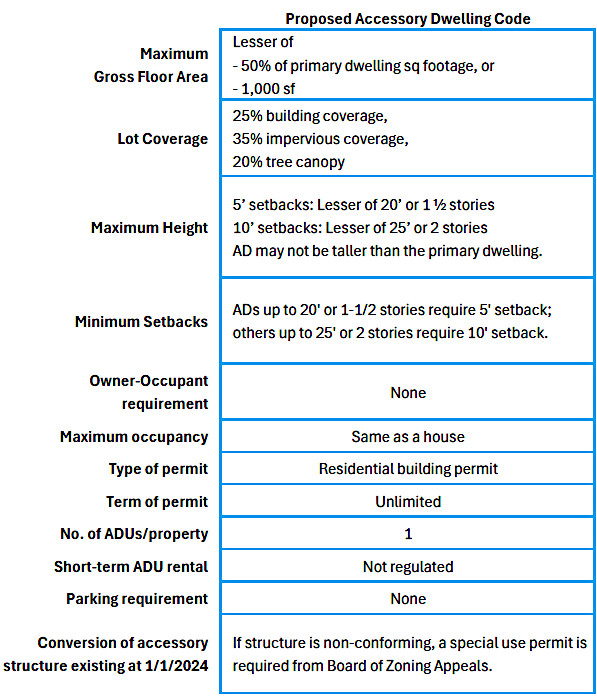
Likely impact
Based on Arlington’s recent 10% AD share of new single-family home construction, and approximately 20 new homes constructed in Falls Church per year, staff estimate that only two ADs would be built in the City each year. They contend, therefore, that the impact on street parking, neighborhoods, and need for new City services would be negligible.
Based on six new ADs in Arlington, the City’s estimate of increased real estate value, with tax implications, for lots that add ADs is 15%, even if the cost of building a detached AD in Falls Church is projected to amount to $300,000 to $400,000. Staff also are still exploring whether the City Charter should be amended to reduce the anticipated $27,000 cost for separate water metering, sewer, gas, and electricity connections for the AD unit.
The City Council work session discussion on November 4
On process:
City Manager Wyatt Shields opened the discussion by recognizing that one City Council member had questioned the process by which the City was moving to consider zoning changes for accessory dwellings. He indicated that there had been substantial internal staff discussions regarding changes in both the Comprehensive Plan and the zoning process and asked for Council guidance.
Council Member Erin Flynn noted that there are still several open questions. She expressed frustration that majority views of the Planning Commission had not necessarily been included in the current proposal and recommended referring it to the Planning Commission for a public hearing in order to gain more public consensus on an approach prior to first reading, which tends to box in flexibility. She stated that only a very small proportion of the public, and often the same people, attended the public town halls.
Planning Director Paul Stoddard responded that there would be further revisions to the proposal based on Council and Planning Commission comments prior to first reading, currently planned for November 25, with no requirement that the City Council agree to it at that point.
City Attorney Sally Gillette said she would prefer not to have first reading and a public hearing on the same night, noting there should be a gap between the two to consider public comments. In particular, she said that a first reading makes it more difficult to modify the approach, and any significant changes in the text can require a new first reading.
Council Member Marybeth Connelly said that she had never seen such a robust public engagement process; the fact that perhaps only 25 people showed up may be an indication that there is not a lot of interest. She suggested that others can get engaged in the next couple of months if they so desire. On balance, she thought the current process as proposed is fine.
Mayor Letty Hardi indicated that although in Fairfax County the Planning Commission initiates proposals, it is up to the City Council to decide the process here. First reading traditionally has been the point at which proposals are referred to Boards and Commissions; the Planning Commission is currently scheduled for three more meetings on ADs after first reading. She agreed that the current proposed process is fine, but sought guidance from the City Attorney on whether the City Council should advertise the “widest” possible provisions in first reading, permitting them to be pared back without having to go back to first reading again.
Council Member Justine Underhill focused on the critical issue of getting all questions answered as part of the process.
Council Member David Snyder contended that first reading has both legal and symbolic significance, underscoring that there are a lot of remaining issues, in particular short-term rentals, that need to be addressed first. He suggested that a public referendum should be considered and expressed concern that staff continued to focus primarily on the positive aspects of ADs without adequate reflection of their negative aspects, that dot voting had been over-emphasized as the product of the public town halls, and that it would be difficult to avoid conflict if the proposal were put out as is at first reading.
On the Code changes, considered by item:
Size of accessory dwellings
The potential size and number of prospective ADs spurred Council questions. Council Member Flynn asked how many parcels in the City might be able to accommodate ADs, eliciting a response from Senior Planner Jack Trainor that this issue is the subject of ongoing analysis, and staff hope to have an answer when this comes back to Council. Mayor Hardi noted that the Housing Commission had proposed up to 1,500 square feet in gross floor area, but Planning Director Stoddard said that 500 – 900 square feet is the standard. Staff preferred to stick with 1,000 square feet to emphasize ADs as clearly accessory to the principal dwelling.
Lot coverage and tree canopy
There was no discussion on the proposed maintenance of the current building and impervious area restrictions. However, Council Member Flynn noted that according to the Urban Forestry Commission, the 20% tree canopy requirement only applies if there is at least a 2,500 square foot land disturbance. She asked staff to look into whether a smaller disturbance would mean the potential for no tree canopy requirement. Staff indicated they were exploring whether a smaller disturbance number would be feasible. Vice Mayor Debbie Schanz-Hiscott also encouraged staff to consider requiring that replacement tree plantings only be native trees.
Parking
There was a clear division of views on eliminating any off-street parking requirement for ADs, as currently required for internal ADs. Council Member Flynn asked for a more nuanced requirement for off-street parking, including consideration of the distance to Metro or whether there is saturated on-street parking in certain areas, as is done in other jurisdictions. However, Council Members Underhill and Schantz-Hiscott and Mayor Hardi preferred to stick with no off-street parking due to its cost and increase in impervious surface.
Short-term rentals

There was an extensive discussion on whether to allow short-term rentals in ADs, given concerns that the City’s objectives for ADs include helping address the housing crisis and permitting City workers to live within the City, which seem at odds with attracting those who would vacation rather than live here longer term.
Council Member Flynn reminded the Council that the Planning Commission wanted to have a City-wide approach proceed in tandem with any action on short-term rentals for ADs. She questioned whether there would be any legal or good faith issues if Council later responded to community concerns with such rentals by shutting them down, having “sold” construction of ADs partly on the basis of potential income from Airbnb rentals.
She also pointed out the potential competition with hotels at a time when the City is opening new hotels seeking business. In sum, Council Member Flynn proposed requiring rentals to be more than 30 days as a potential compromise between those strongly advocating ADs and those concerned about the impact of rentals within neighborhoods in order to have broader consensus around this ordinance. In a further intervention she asserted that the issue here isn’t just an individual landowner’s ability to exercise property rights, but also the importance of weighing in balance concerns within the neighborhood and broader community when considering zoning changes.
City Manager Shields acknowledged that the issue of short-term rentals is a major policy issue. He suggested a possible “narrow bore” approach that would prohibit short-term rentals in new ADs as a placeholder until a broader City policy is developed.
Council Member Snyder acknowledged the City Manager’s suggestion and contended that any approval of short-term rental use for ADs, as part of an approach that encourages and supports construction on residential lots that would benefit developers, would be a very significant change that deserves further substantial discussion within the community. He said these are dramatic changes that affect a huge part of the community, and he doesn’t support the approach that is being followed here.
Mayor Hardi responded that Alexandria permits short-term rentals up to 120 days a year. She questioned how current internal ADs would be affected and asserted that she would prefer continuing the current no regulation approach, without a negative bias against detached units, underscoring that the City had prefaced its approach on permitting those who build detached ADs to use them for additional income.
Owner occupancy
Staff have changed their initial recommendation that the owner occupy either the principal dwelling or the AD, to now have no owner occupant requirement. This issue was initially raised by Planning Commissioner Phil Duncan with regard to State Department employees who might be transferred overseas and would no longer occupy the principal dwelling.
Vice Mayor Shantz-Hiscott indicated that she would support rental of both the principal dwelling and the AD and was seconded by the Mayor.
Council Member Flynn encouraged further discussion of this issue within the Planning Commission regarding the potential for an investor to own both the principal home and the AD, and the nature of responsibility if no owner is present when significant issues arise. She suggested perhaps a waiver could be used for an absent State Department owner.
Mayor Hardi referenced the City’s nuisance rules, such as those for noise and trash, as offering potential comfort to neighbors, and current concerns about the constitutionality of owner occupancy requirements. At her prodding, the City Attorney indicated that the City can’t prohibit rentals.
Setbacks and height
Council Member Flynn indicated a preference for 20-foot heights to encourage trees to grow and shade the ADs if the City can’t assure a 20% tree canopy requirement. She also encouraged a further look at land disturbance requirements, noting that a 1,000 square foot AD could create a significant stormwater impact for neighbors if the setback is only 5 feet, which doesn’t allow significant plantings to absorb the stormwater.
Senior Planner Trainor responded that they are working with City staff to see if there are potential alternatives to a full grading plan for ADs that could help to stem such problems.
Dwellings as “accessory structures”
Finally, Council Member Flynn raised the issue whether accessory structures minus some element of “dwelling” could still be used for habitation going forward, or if the Code would be further revised to have all future accessory habitations governed as ADs. Staff will continue to think about this.
The Planning Commission work session on November 6
In opening comments, Chair Robert Puentes asked staff to summarize the Council’s discussion on short-term rental policy. Senior Planner Trainor indicated that there was a concern that if short-term rentals were not regulated now, but restrictions were put in place later, there might be legal or other consequences based on the City’s encouragement of ADs in part to enable property owners to earn additional income. He noted that the City Attorney is looking at elements of the short-term rental policy and said staff will report back to the Commission.
Commissioner Phil Duncan indicated that he is ready for Council to formally consider the proposed AD zoning changes, believing that staff have adequately framed the issues even without a consensus and that there is a need to keep moving forward.
Commissioner Sharon Friedlander centered her comments on the purpose of an AD: whether the Code changes are designed to focus on family members and possibly caretakers or as a profit center. She said the City can’t simply postpone consideration of short-term rentals to a later date; they would change the nature of the City. She is not on board with this concept. If only long-term rentals are permitted, there is no problem if the owner moves overseas.
Commissioner Brent Krasner said he didn’t see the Planning Commission’s last discussion on ADs incorporated in the current proposal, which reflects very few changes from the earlier “framework”. He believes the deletion of owner occupancy requirements is a mistake (both Fairfax and Arlington have them), suggesting their absence invites investors to get what they can out of City residential lots. Short-term rentals have different impacts than long-term rentals – there has to be follow-up consideration right away.
He also said that nothing in these provisions addresses internal ADs, which account for the majority of units in Northern Virginia. Again, the impacts of internal and detached units are quite different.
Commissioner Krasner argued that a 20-foot height with a five-foot setback are way too tall, especially for R-1B lots, impairing the ability to plant a green screen. He suggested setbacks equivalent to those for the principal home, perhaps deeper for R-1A lots. The use of a Special Use Permit might be appropriate for small lots.
He contended it was not the Planning Commission’s call if the proposal was ready for first reading but emphasized that there were more issues to address.
(Commissioner Krasner is the Branch Chief in the Department of Planning and Development at Fairfax County and was involved in the county’s accessory dwelling code revision.)
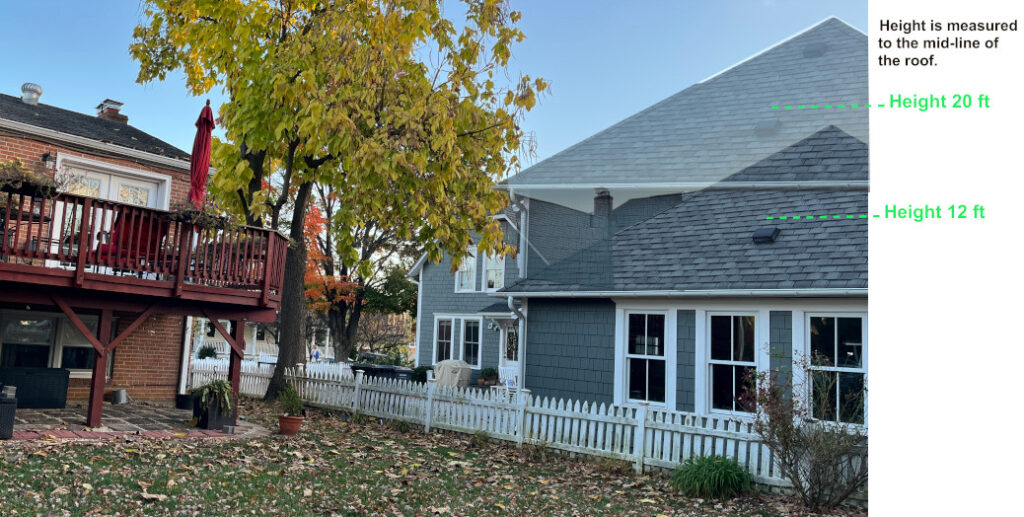
Commissioner Andrea Caumont saw the purpose of the zoning changes to meet the needs of a lot owner on their own property, whether for family purposes or for income. She thought it would be appropriate to address the short-term rental issue after the proposal is passed, and was glad the owner occupancy requirement had been dropped and that no off-street parking spaces would be required. She suggested scaling down the hook-up fees for utilities for the AD, and that the City permit both one internal and one external AD, with an internal AD also permitted in RM and RC districts.
Commissioner Tim Stevens would prefer a smaller gross floor area than 1,000 square feet and lower height. He had some concern about the potential placement of HVACs in the 5- or 10-foot setback area and agreed with Commissioner Friedlander on short-term rentals changing the character of the neighborhood. His approach to the City Manager’s proposal: Don’t permit short-term rentals now unless between long-term rentals or as a bridge if the property is sold.
Commissioner Derek Hyra welcomed the staff’s focus on looking at fiscal impacts for the City. He indicated he could support an AD policy only under three conditions:
- Rentals would be for six months or more;
- an owner occupancy requirement would be included; and
- if the zoning changes were paired with fiscal legislation that any additional tax revenue arising from the AD would go into an affordable housing fund.
Chairman Puentes liked the idea of a contribution to a housing fund, even if small. He was uncertain of his position on short-term rentals at this point. He is OK with the current parking proposal and likes the idea of using Special Use Permits in certain situations and scaling down utility fees for the AD.
Commissioner Duncan concluded with a recommendation that staff add a paragraph on potential concerns about these zoning changes, to address those who say the treatment has been biased.
Schedule going forward
City staff propose the following series of discussions into next year:
Phase IV – Formal Consideration November 2024 – February 2025
- City Council First Reading November 25, 2024
- Planning Commission Work Session December 4, 2024
- Walking Tour December 2024
- Two Open House/Community Town Halls in December 2024
- Planning Commission Work Session – Markup January 2025
- City Council Final Work Session February 2025
- Planning Commission Public Hearing March 2025
- City Council Final Consideration March 2025
References
- City staff report for the City Council and Planning Commission discussions on November 4 and 6, 2024, respectively
- City Council work session on November 4, 2024. This official video will not display properly on a small screen as it includes the agenda.
- City Council work session on November 4, 2024. YouTube video.
- Planning Commission work session on November 6, 2024. YouTube video, starts at accessory dwelling discussion.

